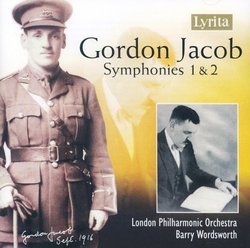Unjustly Neglected Symphonies
D. A Wend | Buffalo Grove, IL USA | 07/31/2009
(5 out of 5 stars)
"Gordon Jacob dedicated his Symphony No 1 to his brother Anstey, who was killing during the battle of the Somme. The music was written in 1929 but, aside from a play-through in 1932, it was never performed. This is the premiere recording, and it is hard to understand why no performance was forthcoming. The symphony is in five movements and scored for a large orchestra.
The first movement opens with a brief introduction for full orchestra with a trumpet playing a brief fanfare. The work embarks on a vigorous and heroic melody vigorous melody. There is a great deal of interplay between strings and brass until the strings begin the second, tranquil melody. The chief melodies are developed and the movement closes with a great flourish. The second movement is marked Lento and was described by the composer as a funeral march. The use of brass made me think of a connection to the war, as if describing a grim battlefield. A reflective theme is introduced and slowly builds to a climax with a gong strike when the beginning melody is brought back with more anguish. The third movement is a scherzo beginning with a jaunty melody for the woodwinds. Contrasting themes dominate the movement punctuated by a rustic dance. The fourth movement has a bucolic feel to the opening melody, as if looking at a country landscape. The strings dominate the music with a beguiling brief tune for the woodwinds. The last movement is a rondo that is reminiscent of Vaughan Williams. The music is dominated by the brass with bold, vigorous melodies.
The Symphony No 2 was composed in 1945 and unlike the first received a performance in May 1946. The symphony begins with an extended Adagio; then a fanfare by a trumpet announces the shift to the brass dominated chief melody. The music develops into a reflective passage before bringing back the main theme. The second movement is an Adagio characterized by somber brass chords and lonely sounding strings. The movement is very subdued. The scherzo is assertive with leaping melodies and a trio section for strings alone; the brass returns with the opening melody. The finale is a theme with 27 variations. The movement plays with tonality between the variations and ends brilliantly with a flourish by the full orchestra.
The London Philharmonic Orchestra conducted by Barry Wordsworth performs both symphonies with passion and commitment. It is hard to believe that this music has suffered so much neglect. The recording is clear and well balanced.
"


 Track Listings (9) - Disc #1
Track Listings (9) - Disc #1